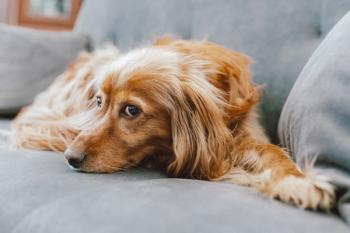
Full tilt! Diagnosing and managing vestibular dysfunction in dogs and cats (Proceedings)
The vestibular system is responsible for the maintenance of balance and equilibrium in the body, and is comprised of a number of anatomic structures. The semicircular canals are located within the thick petrous temporal bone of the skull, and are composed of three bony canals containing membranous ectoderm structures (semicircular ducts) filled with fluid (endolymph).
Anatomy and Physiology
The vestibular system is responsible for the maintenance of balance and equilibrium in the body, and is comprised of a number of anatomic structures. The semicircular canals are located within the thick petrous temporal bone of the skull, and are composed of three bony canals containing membranous ectoderm structures (semicircular ducts) filled with fluid (endolymph). Sensory information gathered from movement of this endolymph is transmitted to the brain via the vestibular nerve, which together with the auditory nerve, comprises the eighth cranial nerve (CN VIII). Cranial nerve VIII enters the brainstem at the level of the medulla oblongata, and most axons synapse within the vestibular nuclei. Projections from the vestibular nuclei travel to centers controlling extensor tone of the limbs, vomiting centers, and the nuclei of cranial nerves III, IV, and VI, which control the extraocular muscles and together coordinate eye movement. In addition, projections to the flocculonodular lobes of the cerebellum serve to coordinate movements of the eyes and limbs with movement of the head. Thus, vestibular signs can result from disease processes affecting the semicircular ducts, vestibular nerve, medulla oblongata, or cerebellum. It is useful to separate these structures into those within the central nervous system (CNS, central; i.e., medulla oblongata and cerebellum) and those outside of the CNS (peripheral; semicircular ducts and vestibular nerve), as different disease processes occur in these two regions, with potentially different diagnostic and therapeutic plans.
Clinical Signs of Vestibular Disease
Vestibular dysfunction manifests as a very characteristic group of clinical signs, including ataxia, head tilt, nystagmus, and strabismus. The ataxia is usually characterized by drifting, leaning and falling to one side, and affects all four limbs. In acute, severe cases, the animal may be nonambulatory, and may lie on one side, with twisting and rolling when attempts are made to place the animal on the other side or in sternal recumbency. The trunk may be flexed laterally, or the animal may walk in tight circles. A head tilt is frequently present, characterized by a deviation of the head from the horizontal plane (as opposed to a head turn, deviation from the sagittal plane, a feature of forebrain disease). Spontaneous nystagmus consists of abnormal movement of the eyes, usually characterized by a fast and slow phase of movement. This movement may be horizontal, vertical or rotatory in nature, and may change or be elicited only with certain body positions (e.g., dorsal recumbency). Absence of normal physiologic nystagmus, seen when the head is moved in an arc laterally, may also be noted. A positional strabismus is often seen, with ventral deviation of the globe ("eye drop") on elevation of the head. With acute lesions, nausea may occur, with vomiting and inappetence.
Lesion localization
Peripheral
Involvement of the peripheral vestibular system (semicircular ducts or vestibular nerve) results in signs of vestibular dysfunction without accompanying signs of brainstem (medulla oblongata) involvement. Therefore, animals typically present with ataxia, head tilt, horizontal or rotatory nystagmus, and positional ventral strabismus with no evidence of postural reaction, proprioceptive or motor deficits. The head tilt is towards the side of the lesion, and the fast phase of the nystagmus is away from the side of the lesion. The facial nerve (CN VII) and the sympathetic innervation to the eye course through the middle ear. Due to the proximity of the inner and middle ear compartments, it is common for peripheral vestibular disease to be accompanied by facial nerve paralysis (absent palpebral reflex and menace response, droopy lip) and Horner's syndrome (enophthalmos, ptosis, miosis, and prolapsed nictitans).
Bilateral vestibular dysfunction
Bilateral vestibular dysfunction is unusual, but may occur with involvement of the vestibular nerves or semicircular canals on both sides. These patients have a very characteristic appearance, with wide, swinging excursions of the head to either side. They show ataxia of all four limbs, often with a low, crouching or crawling posture/gait, but a head tilt and spontaneous nystagmus are absent. However, an absence of physiologic nystagmus supports bilateral involvement.
Central
Animals with central vestibular dysfunction involving the brainstem show typical signs of vestibular disease along with reduced or absent postural reactions (proprioceptive positioning, hopping, hemistanding, hemiwalking, and placing responses) and hemiparesis on the side of the lesion. The head tilt is usually towards the side of the lesion, although with involvement of the cerebellum or cerebellar peduncles, it may be away from the side of the lesion (so-called "paradoxical vestibular disease"). Vertical nystagmus or nystagmus that changes direction with alteration of body position suggests a central lesion, although more typical horizontal and rotatory forms can also be seen. Deficits of other cranial nerves exiting the medulla can also be seen, and altered mentation or spinal pain also suggest a central lesion.
Differential diagnosis
Peripheral
• Otitis media-interna – This is typically a bacterial infection, which often spreads from the external ear canal. However, otitis media-interna may occur without external ear canal disease, through extension from the auditory tube. Less common causes are fungal and non-infectious etiologies (e.g., secretory otitis).
• Inflammatory polyps – Polyps are masses of inflammatory tissue that arise from the auditory tube, and may invade the middle and inner ear. They are typically seen in young cats.
• Hypothyroidism – Hypothyroidism can cause peripheral neuropathies of single cranial nerves, including the vestibular nerve. The pathophysiology remains unclear, but is likely related to either metabolic dysfunction in the nerve fibers or compressive neuropathy secondary to mucinous soft tissue deposits.
• Neoplasia – Neoplastic disease of CN VIII is very rare in animals, but the nerve or semicircular canals may be secondarily involved with tumors of the adjacent bone or soft tissue structures.
• Idiopathic – There are several idiopathic syndromes causing peripheral vestibular dysfunction in small animals. A condition seen in young cats is thought by some to be caused by Cuterebra migration. Elderly and geriatric dogs may have acute onset of peripheral vestibular signs (often quite severe) due to an idiopathic condition (often called "old dog vestibular disease" or "geriatric vestibular disease").
• Trauma – Dysfunction of the vestibular apparatus secondary to trauma is relatively uncommon, but can occur with fractures of the petrous temporal bone.
Central
• Anomalous – Vestibular dysfunction has been reported secondary to Chiari-like malformation/Caudal occipital malformation syndrome, but is rare with this disease process. Anomalous cystic lesions of the brain (e.g., dermoid, epidermoid, arachnoid cysts) may occur in the region of the cerebellomedullary junction, leading to vestibular signs.
• Hypothyroidism – Hypothyroidism has also been implicated in causing central vestibular dysfunction. Some dogs have lesions consistent with infarction on imaging studies, although in others the pathophysiology remains unclear.
• Neoplasia – Neoplastic disease of the brainstem is a common cause of central vestibular signs. Meningiomas and choroid plexus tumors are the most common tumors that occur in this area.
• Meningoencephalitis – Meningoencephalitis is a common cause of central vestibular dysfunction. The inflammatory process may be related to an infectious organism, or may be presumably sterile (e.g., granulomatous meningoencephalitis [GME]).
• Metronidazole intoxication – Toxicosis related to metronidazole administration may cause central vestibular signs. Affected animals are usually receiving very high doses of the drug, often for prolonged periods of time.
• Cerebrovascular accident – Stroke is a common cause of central vestibular dysfunction, and may occur secondary to infarction or hemorrhage. A multitude of underlying etiologies may contribute to the development of stroke in small animals, although the cause is frequently not found.
Diagnostic plan
The diagnostic plan for vestibular disease depends on whether the lesion is believed to be in a peripheral or central location. For peripheral lesions, a thorough examination of the external ear canals and tympanic membranes should be performed. A myringotomy should be considered depending on these results as well as imaging tests. This may be performed with the use of a spinal needle or by breaching the tympanic membrane with a small culturette. Culture and cytology of the external and middle ear compartments may also be indicated. In young cats, inflammatory polyps may be visualized through the tympanic membrane or in the pharyngeal region. Visualization may be facilitated by utilizing a spay hook to move the soft palate aside. Serum chemistry analysis and a thyroid panel aid in the diagnosis of hypothyroidism. Imaging tests for peripheral disease include radiographs of the tympanic bullae, which should be obtained under heavy sedation or general anesthesia. Computed tomography (CT) and magnetic resonance imaging (MRI) are very useful tests to evaluate the tympanic bullae and inner ear structures, and provide greater sensitivity in the detection of lesions when compared with radiographs. Detectable lesions include otitis, inflammatory polyps, neoplasia and trauma. Idiopathic syndromes are diagnosed based on elimination of other etiologies, or by observing improvement of clinical signs in an animal of the appropriate signalment.
For animals with central vestibular lesions, the main diagnostic tests providing useful information are MRI, cerebrospinal fluid (CSF) evaluation, and possibly brainstem auditory evoked response (BAER). Examination of the brainstem with MRI is superior to CT, as the latter is prone to artifacts that obscure visualization of this region of the brain. Together, these tests allow identification of most of the disease processes creating lesions in this area. Infectious disease testing of blood and CSF samples should also be considered, as should evaluation of thyroid function.
Treatment plan
Treatment should be directed at addressing the underlying etiology, underscoring the importance of differentiating peripheral from central disease and performing appropriate diagnostics. Otitis media-interna is treated with appropriate bone-penetrating antibiotics for at least 6-8 weeks. Refractory otitis cases as well as inflammatory polyps may benefit from surgical intervention (e.g., bulla osteotomy). Dogs with hypothyroidism often respond to levothyroxine administration. Animals with metronidazole intoxication usually recover completely with cessation of the drug. Stroke patients usually recover or make substantial improvements with just supportive care and time. Meningoencephalitis is treated with antimicrobials if an infectious agent is identified, or typically with glucocorticoids and other immunosuppressive drugs if not. Options for animals with neoplastic disease include surgical debulking, radiation and possibly chemotherapy. Animals with idiopathic vestibular syndromes usually improve dramatically with just supportive care over the course of days to weeks.
Newsletter
From exam room tips to practice management insights, get trusted veterinary news delivered straight to your inbox—subscribe to dvm360.






